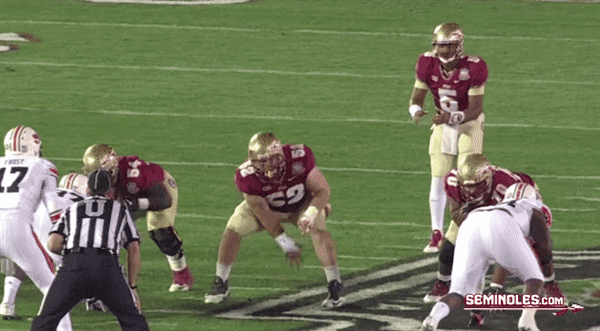Film Breakdown: FSUs offensive line


Advertisement
Click Here to view this Link.

Click Here to view this Link.

Click Here to view this Link.
Warchant's Film Breakdown feature is back for another year, and this season we are glad to be adding a new wrinkle for the best subscribers in the business. Be sure to check out former FSU center David Castillo's insights on offensive line responsibility above this written piece.
Game week is almost here, but before we look at the Seminoles' opening opponent, Oklahoma State, we'll explore the offensive line and some of the plays FSU coach Jimbo Fisher draws up in the running game. After a look at zone runs, we'll also delve into Coach Fisher's opinions on guard play and the importance of interior linemen as they relate to pocket integrity.
Run blocking/Zone schemes
Florida State returns an experienced and talented offensive line this season. The only "new" projected starter is Austin Barron, who has filled in for Bryan Stork on numerous occasions. The linemen will look to improve upon their already impressive run blocking ability and accolades from a season ago, when they paved the way for the team's top three running backs to average nearly seven yards per carry (6.94).
FSU utilizes zone schemes in the running game, which require offensive linemen to not only be agile, but to also have good awareness in determining how the defense is lining up. Each blocking assignment is determined by where the defensive linemen and linebackers are aligned.
Using this running play against Auburn as our first example, let's identify the blocking assignments.
We see the nose tackle lined up on the inside shoulder of Florida State right guard Tre' Jackson. This means that Jackson is covered and will require the help of center Bryan Stork to get freed up to the next level of defenders. The direction of the run is to the right, therefore it should also be noted that left tackle Cameron Erving will ignore the weakside defensive end in an effort to free up Josue Matias to get to the next level. In addition, because the play is going to the right side, it means right tackle Bobby Hart will have to win his matchup with the strongside defensive end. Tight end Nick O'Leary, completing pre-snap motion, picks up the linebacker playing at the line of scrimmage.
As you can see looking at the replay in real time, the success of the run is dependent on Jackson shedding the nose tackle at the line of scrimmage and Hart securing his man in a one-on-one situation.
Now that we have an idea of what a successful zone scheme looks like, let's take a look at a play where the 'Noles had a breakdown.
Once again, Jackson is covered by the nose tackle on a running play to the right side of the formation. While this is a different formation, the same rules apply, meaning Stork will help free up Jackson to get to the next level and Hart will have to win his one-on-one assignment. On the weakside, Erving will ignore weakside rusher Vic Beasley to free up Matias.
Hart is unable to keep his assignment from disrupting the play in the backfield, forcing running back Devonta Freeman to cut back to the left, where he has little room to operate and even less yards to gain. Stork has difficulty moving the nose tackle because Jackson does not provide initial help, and a blitzing linebacker fills the cutback lane. It all adds up to contact in the backfield.
Zone blocking requires linemen to work together on a string. One missed block or assignment can often destroy a play's chances of having success. The continuity created by having five senior starters should help FSU boast one of the top offensive lines in the country.
Pass protection
Often when discussing pass protection, since the vast majority of quarterbacks are right-handed, the fixture of conversation is the left tackle. While Cameron Erving deserves heightened focus - the senior is projected to be a high draft pick in April - the interior linemen also are critically important.
During his chat with reporters at FSU Media Day, we had a chance to ask Coach Fisher about guards Josue Matias's and Tre Jackson's importance to the offense. Fisher gave a thorough, coaches' camp-style answer, calling interior line play, "more critical now than it's ever been in football." He also stressed a necessity for increased guard size.
"Everybody talks about the athletic guys outside, but the integrity of that core of that pocket, where that guy has got to be able to step up and make a throw has changed," Fisher said. "[It] has really changed the game. It's why you're seeing more guards going in the first round than have ever gone before."
According to Fisher, it's all part of a defensive goal to affect the quarterback up the middle - not necessarily through sacks, but through pocket pressure.
"See, if I'm a quarterback," Fisher said as he swiveled, hands high with an imaginary ball close to his right ear, "I'd rather have a guy come scot-free off the end than to take all four of them and just walk in. ... That can cause as many interceptions and turnovers. Would you rather have a sack or you rather have a turnover? ... So the integrity of the core of the pocket, now, is getting bigger than ever."
Quick Facts: Seminole Offensive Line
The projected starters as of today - Erving, Matias, Barron, Jackson and Hart - average a height of over 6-foot-4 and a weight of 314.6 pounds.
Top reserves who are cross-training - Kareem Are and Roderick Johnson average taller than 6-foot-6 and 327.5 pounds.
The projected starting five has a combined 113 college starts. Other top opponents' projected starters and their experience: Oklahoma State (34), Clemson (44), Notre Dame (52), Louisville (127), Miami (73), Florida (48).

Click Here to view this Link.